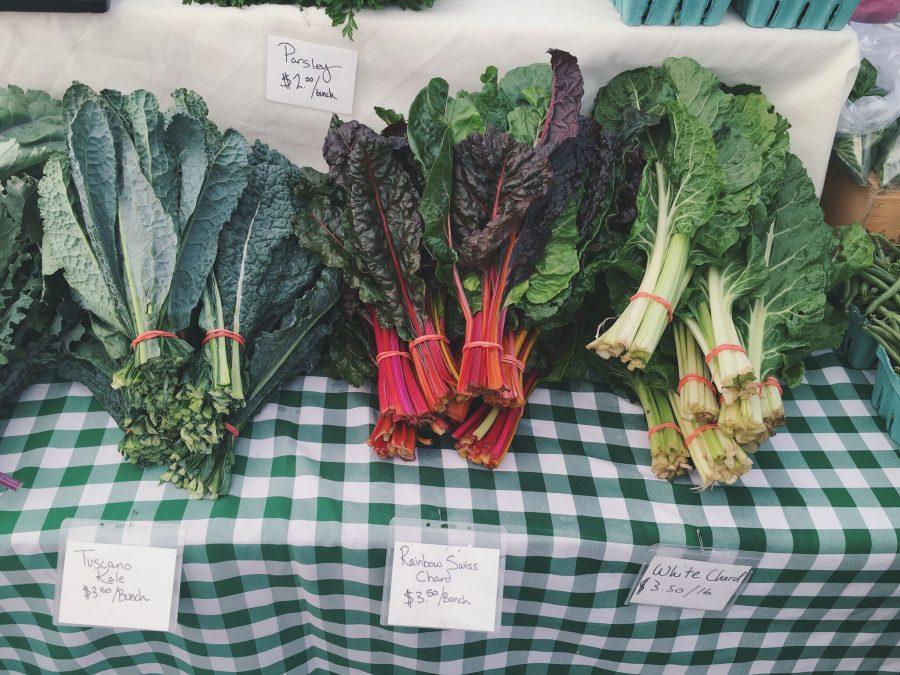Dethroning Kale As the Trendiest Green
Kale and Swiss Chard at Union Square Greenmarket.
November 2, 2016
Kale. This may be your fifth time reading something about kale and, because you live in a city obsessed with the newest health trends, you have probably consumed something with this leafy green in it today.
Here are some quick facts about your favorite veggie. Kale is packed full of Vitamins K, A and C and was enjoyed as early as the Middle Ages. This cruciferous vegetable hailed as a cancer fighter is a part of the Acephala group, which includes collard greens such as cabbage, broccoli and arugula to name a few.
So if they’re related, do other vegetables share these health benefits? Mustard greens, for example, have been considered a close second to kale as they not only significantly lower cholesterol level, but also work as a cancer-fighting superfood filled with the same great amount of Vitamin K, which prevents heart disease. Mustard greens have a unique taste which will add the perfect kick to any plain salad while maintaining a bitterness comparable to that of kale. Turnip greens are also a great alternative that are not only delicious but are also filled with the same amount of Vitamin K. Swiss chard, beet greens, broccoli rabe and dandelion greens are just a few greens that offer the same benefits and have unique flavor profiles as well.
To break it down, kale may have more Vitamin A and C in it compared to some of the greens in its family. However, Swiss chard has more iron (22 percent) and collard greens have more calcium, protein and iron than Kale. Mustard greens are also lower in calories but offer more protein and calcium. Ultimately, all leafy greens have health benefits.
Then how did kale get so popular? Believe it or not, the American Kale Association recruited someone to make it popular and starting in NYC, the birthplace of the newest, hippest trends. Oberon Sinclair, who has worked for fashion powerhouses such as Hermes and Givenchy, partnered with AKA to make kale what it is today. Maybe it is the Vitamin K, maybe it is because it is truly a healthy green, but in the end kale’s popularity is mostly due to Sinclair.
CAS freshman and health food lover Emily Fagel remains a fan of kale despite the questionable origin of its popularity.
“I enjoy it cooked or uncooked, although I really only discovered it because it’s so popular,” Fagel said. “I’m sure other greens have equal nutritional value. I prefer it to other greens in salads because, unlike spinach or lettuce, it has a flavor of its own, making the green element of the salad more interesting.”
However, LS freshman Thomas Chou prefers spinach. He said that kale has just become essentially trendy and cool.
“Over the years, if feels like kale has changed from being popular because of its nutritional value to being popular for the sake of being popular,” Chou said. “While I like kale and have eaten it for years, I think that the way that some people treat it like a miracle vegetable is somewhat over-the-top.”
Popularity aside, fitness instructor Monique Ochoa believes the only problem with the popularity of kale is that it causes other vegetables to be overlooked.
“I think kale is a great source of iron, but there are several other vegetables that offer just as much or more iron like spinach and broccoli,” Ochoa said. “They are a little more versatile as far as including them in different meals.”
Branch out and try other leafy greens that have been ignored for too long, because Kale is definitely not the only green that offers a punch of nutrients.

Data Source: SELF Nutrition Data
Email Liv Chai at [email protected].




























































































































































